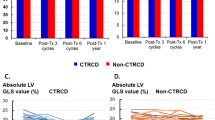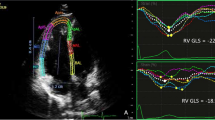Summary
Adriamycin (ADM) is an effective antineoplastic drug. However, the amount of ADM that can be administered must be limited because of the risk of developing a severe dose-dependent cardiomyopathy. 4′Epi-adriamycin (4′ ADM) is a new anthracycline analog with similar antineoplastic properties as ADM, but with perhaps less cardiac toxicity. To determine myocardial performance after a chronic treatment with 4′ADM, we studied 17 patients (mean age 36.6 years) suffering from lymphomas by means of 24-hour ambulatory ECG, x-ray, M-mode echocardiogram, and rest-exercise gated radionuclide ventriculography (RNV), performed prior to and 2 months after the end of the treatment. Pretreatment and post-treatment shortening fractions, basal pretreatment and post-treatment ejection fractions, and postexercise pretreatment and post-treatment ejection fractions, were tested for correlation with individual 4′ADM doses and pretreatment with ADM. No association was noted among them, showing the lack of correlation between doses and impairment of ventricular performance. 4′ADM doses ranged from 400 to 1100,\(\bar x\) 748±174 mg/m2; allnoninvasive studies including RNV doses and RNV (Pearson's correlation coefficient, p=ns). No deterioration of ventricular performance could be demonstrated. Conversely, the basal pretreatment ejection fraction changed from 56.17±7.6% to 61.52±8.3% in posttreatment (p<0.0001). Surprisingly, the postexercise pretreatment ejection fraction also increased from 55.47±7.7% to 63.35±10% in post-treatment (p<0.03). The shortening fraction changed from 35.47±4.8% to 36.47±4.2% after 4′ADM treatment (ns). No impairment of cardiac function could be shown in patients previously treated with ADM or radiotherapy. On the basis of these data, treatment with 4′ADM did not impair but improved cardiac function
Similar content being viewed by others
References
Henderson IC, Frei A. Adriamycin cardiotoxicity.Am Heart J 1980;99:671–674.
Von Hoff DD, Rozencweig M, Piccart M. The cardiotoxicity of anticancer agents.Semin Oncol 1982;9:23–33.
Arcamone F, Penco S, Vigevani A, et al. Synthesis and antitumor properties of new glycosides of daunomycine and adriamycine.J Med Chem 1975:18:703–707.
Bonfante V, Bonadonna G, Villani F, et al. Preliminary phase I study of 4′epiadriamycin.Cancer Treat Rep 1979; 63:915–918.
Casazza AM, Di Marco A, Bertalozzi C, et al. Antitumor activity, toxicity and pharmacological properties of 4′epiadriamycin.Curr Chemother 1978;2:1257–1260.
Casazza AM, Di Marco A, Bonadonna G, et al. Effects of modifications in position 4 of the chromophore in position 4′ of daunorubicin and doxorubicin. In Crooke ST, Reich S, eds,Anthracyclines: Current status and new developments. New York: Academic Press, 1980.
Milei J, Bolomo NJ, Marantz A. Prenylamine inhibition of adriamycin-induced cardiomyopathy in mice.Medicina (B. Aires) 1982;42:409–414.
Llesuy S, Milei J, Molina HA, et al. Comparison of lipid peroxidation and myocardial damage induced by adriamycin and 4′-epiadriamycin in mice.Tumori 1985;71:241–249.
Milei J, Boversis A, Molina HA, et al. Prenylamine inhibition of adriamycin-induced myocardiopathyActa Cardiol 1985;40:383–396.
Milei J, Boveris A, Llesuy S, et al. Amelioration of adriamycin-induced cardiotoxicity in rabbits by prenylamine and vitamins A and E.Am Heart J 1986;111:95–102.
Milei J, Marantz A, Alé J, et al. Prevention of adriamycininduced cardiotoxicity by prenylamine.Cancer Drug Deliv 1987;4:129–136.
Alé J, Zori Comba A, Otero F, et al. Radionuclide ventriculography in the assessment of 4′epiadriamycin-myocardial performance. X Congress of Cardiology. Washington. DC, September 1986, Am. Heart Assoc.
Llesuy S, Milei J, Gonzalez Flecha BS, et al. Evaluation of myocardial damage induced by doxorubicins: Correlation with in vitro chemiluminiscence.Free Rad Biol & Med 1990;8:259–264.
Druck M, Gulenchyn KY, Evans WK, et al. Radionuclide angiography and endomyocardial biopsy in the assessment of doxorubicin cardiotoxicity.Cancer 1984;13:1667–1673.
Vazquez Blanco M, Milei J, Pineiro DJ, et al. Long term treatment of ventricular tachycardia in ambulatory patients with amiodarone.Acta Cardiol. 1983;38:125–132.
Green MV, Ostron HG, Douglas MA, et al. High temporal resolution ECG gated scintigraphic angiocardiography.J Nucl Med 1975:16:95–98.
Cortes EP, Lutman G, Wanka J, et al. Adriamycin (NSC-123127) cardiotoxicity: A clinicopathologic correlation.Cancer Chemother Rep 1975;6:215–225.
Praga C, Beretta G, Vigo PL Adriamycin cardiotoxicity: A survey of 1273 patients.Cancer Treal Rep 1979;63:827–834.
Balcueva E, Schaiberger C, Masud K, et al. Determination of early adriamycin induced cardiotoxicity by impedance cardiography. In: Siegenthaler A, Luthy R, eds,Current Chemotherapy. Washington, DC: American Society of Microbiology, 1978:1253–1225.
Villani F, Beretta G, Guindani A. Evaluation of early doxorubicin-induced cardiotoxicity by means of systolic time intervals.Cancer Chemother Pharmacol 1979;3:249–251.
Blum RH, Carter SK, Adriamycin, a new anticancer drug with significant clinical activity.Ann Intern Med 1974;80:249–254.
Villani F, Beretta G, Guindani A, et al. Valutazione policardiografica della cardiotossicita da adriamicina.Giorn Ital Chemiot 1975;22:39–46.
Al-Ismail SAD, Whittaker JA. Systolic time intervals as index of schedule dependent doxorubicin cardiotoxicity in patients with acute myelogenous leukemia.Br Med J 1979;1:1392–1395.
Casazza AM. Preclinical studies for the evaluation of new anthracycline analogs.Chemioter Oncol 1978;2:310–326.
Torti FM, Bristow MM, Lum BL, et al. Cardiotoxicity of epirubicin and doxorubicin: Assessment by endomyocardial biopsy.Cancer Res 1986;46:3722–3727.
Author information
Authors and Affiliations
Rights and permissions
About this article
Cite this article
Milei, J., Ale, J.J., Garay, G. et al. Hemodynamic effects of chronic 4′ epi-adriamycin administration. Cardiovasc Drug Ther 4, 1519–1523 (1990). https://doi.org/10.1007/BF02026501
Issue Date:
DOI: https://doi.org/10.1007/BF02026501




